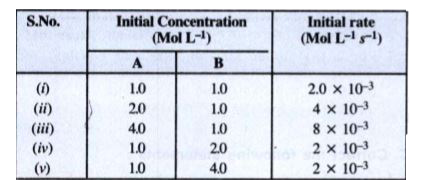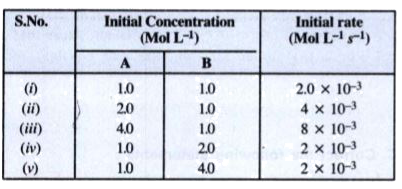Rate of reaction, A+B→ products is given below as a function of different initial concentration of

Determine the order of the reaction with respect to A and B. What is the half-life of A in the reaction?
(i) A=1, B=0 (ii) t1/2=1.386 min
Looking at the rate data of experiment number 1 and 2 indicates that rate is doubled on doubling concentration of A while concentration of B is constant. Therefore, order with respect to A is 1. Similarly, comparing data of experiment number 1 and 3, doubling concentration of B, while concentration of A is constant, has no effect on rate. Therefore, order with respect to B is zero.
⇒ Rate =k[A]⇒k=0.0050.010=0.5 m in−1=0.693t1/2⇒t1/2=0.6930.5=1.386 m in
Topper's Solved these Questions
- CHEMICAL KINETICS BOOK - VMC MODULES ENGLISHCHAPTER - CHEMICAL KINETICS EXERCISE - JEE Main (Archive)
56 Videos
- CHEMICAL EQUILIBRIUMBOOK - VMC MODULES ENGLISHCHAPTER - CHEMICAL EQUILIBRIUMEXERCISE - IN-CHAPTER EXERCISE - G
10 Videos
- CHEMICAL THERMODYNAMICS BOOK - VMC MODULES ENGLISHCHAPTER - CHEMICAL THERMODYNAMICS EXERCISE - IN - CHAPTER EXERCISE - L
10 Videos
Similar Questions
The rate of reaction A+B→ Product is given by the equation r=k[A][B]. If B is taken in large excess, the order of the reaction would be
View SolutionConsider the reaction, A+B→C+D.
The initial rate for different initial concentrations of the reactants are given below :

Calculate the rate constant.
View Solution
Knowledge Check
The half-life of a reaction is halved as the initial concentration of the reactant is doubled. The order of the reaction is
A0.5B1C2D0The half-life of a reaction is halved as the initial concentration of the reactant is doubled. The order of the reaction is
A0.5B1C2D0The half-life of a reaction is halved as the initial concentration of the reactant is doubled. The order of the reaction is
A0.5B1C2D0
Consider the reaction, A+B→C+D.
The initial rate for different initial concentrations of the reactants are given below :

What are the orders with respect to A and B ?
View SolutionConsider the reaction, A+B→C+D.
The initial rate for different initial concentrations of the reactants are given below :

What are the orders with respect to A and B ?
View SolutionThe half-life of a reaction is halved as the initial concentration of the reaction is doubled. The order of the reaction is
View SolutionIn a reaction between A and B, the initial rate of reaction was measured for different initial concentrations of A and B as given below:

What is the order of reaction with respect to A and B ?
View SolutionIn a reaction between A and B, the initial rate of reaction was measured for different initial concentrations of A and B as given below:

What is the order of reaction with respect to A and B ?
View Solution
